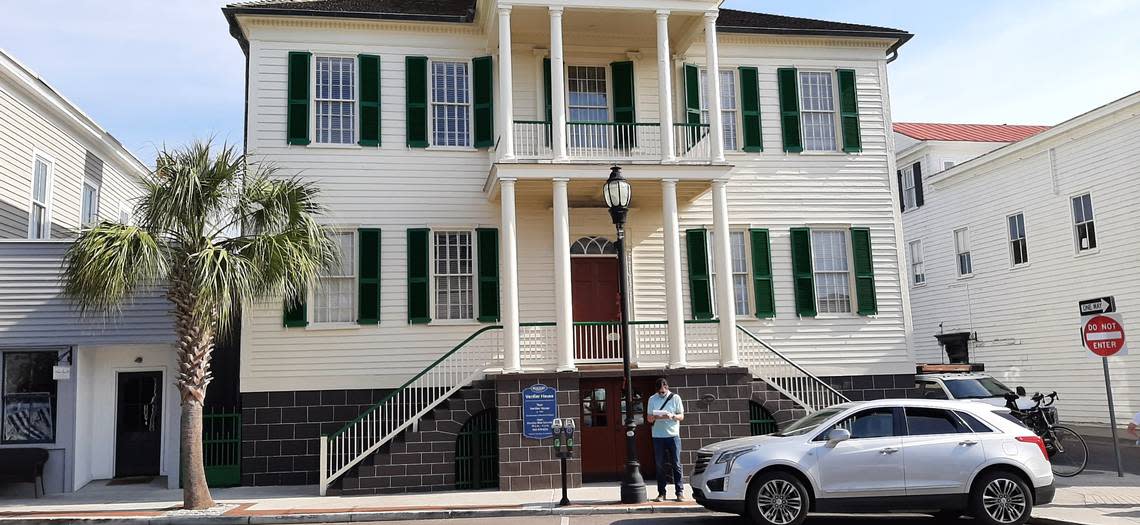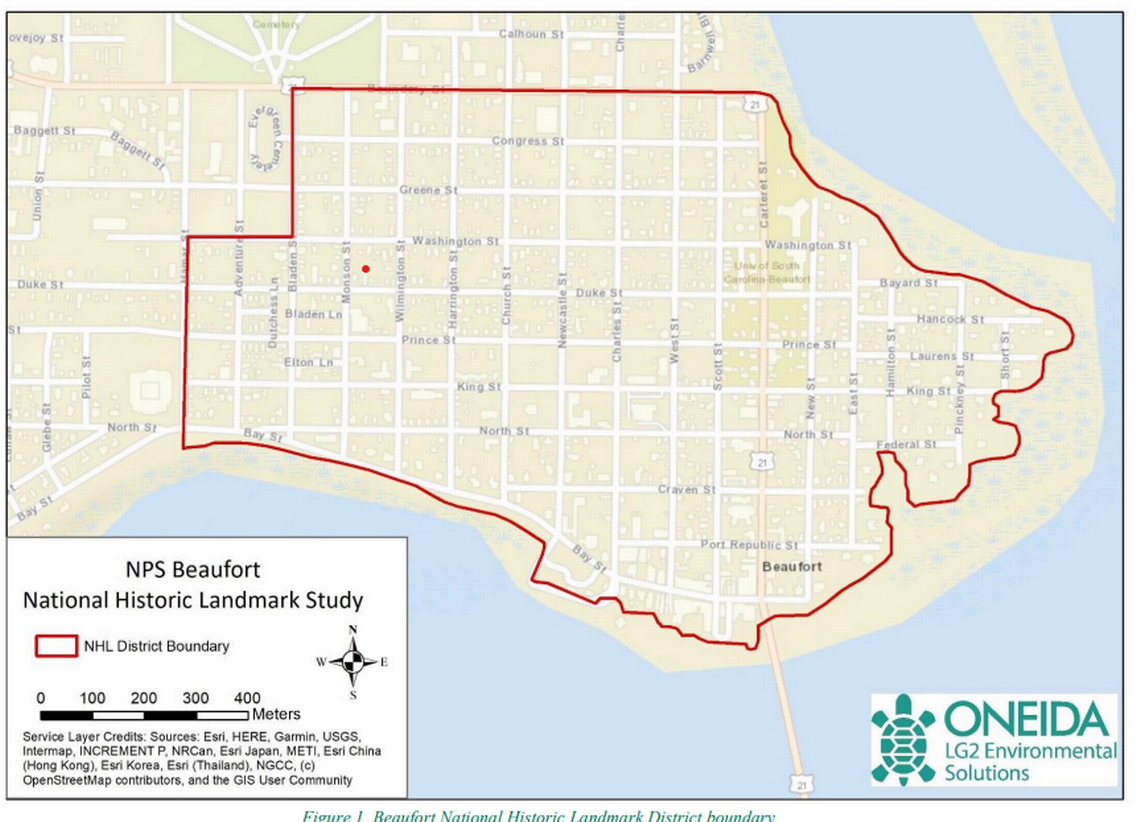Beaufort retains its ‘distinctive character,’ but developments have threatened it, report says
The Beaufort National Historic Landmark District — a source of pride for the city and an economic driver — remains intact 50 years after it was designated by the National Park Service, according to a draft report made available to the public.
But over the years, the demolition of historic buildings, large-scale developments and massive power poles have diminished its integrity, too, the report concludes.
The 300-acre district was designated in 1973, highlighting the city’s national significance for its distinctive southern architecture, which was spared during the Civil War. It consists of 160 residences, churches, commercial and government buildings and landscapes ranging from the early 18th century to the 1910s. It is bounded on the north by Boundary Street, on the east and south by the Beaufort River and on the west by Hamar Street.
“Beaufort as a coastal city is in many ways a unique treasury of Southern American architecture of the first half of the 19th century,” the original nominating application for a federal historic designation said. “Its counterparts may be found in New England — Salem, Mass., Portsmouth, N.H., Providence, R.I. — as examples where fine homes and churches were built during the great days of the clipper ships.”
But in May 2021, critics of large development projects proposed in the city’s historic downtown, citing threats to its historic character, asked the National Park Service to conduct the study. The draft report was released Tuesday.
“In recent years, there have been numerous large-scale developments proposed within the [historic landmark district] that have caused concern among residents and alarmed preservationists, leading individuals and organizations to legally challenge decisions made by the city,” the report states. “The public concerns over ordinance interpretation and enforcement, along with staffing changes within the city, have led to public apprehension and confusion.”

Beaufort has made strides in balancing growth despite the challenges, the report adds, but unresolved issues remain, including conflicts between preservationists and planners, planning staffs’ perceived lack of familiarity with preservation planning, and city approval of controversial projects that many believe the historic preservation ordinance and design guidelines should guard against.
The Park Service is asking the public to comment on the draft report until March 11. The report will be finalized later this year. It identifies the district’s current condition, key threats and makes recommendations to preserve it.
Key findings of the report
The preliminary findings in the report include:
▪ Despite the loss of at least 12 contributing buildings, and insensitive alterations to others, the Beaufort National Historic Landmark District largely retains the distinctive character identified in the 1973 NHL District documentation.
▪ Demolition of buildings and subsequent infill (or lack thereof) has led to a shift in development patterns and changes in building density. Additionally, large and incompatible development and infill has led to changes in the district’s character.
▪ Projects on rights-of-way controlled by the South Carolina Department of Transportation and Dominion Energy such as the addition of monumental, out-sized utility poles, particularly within the Northwest Quadrant, negatively impact and significantly diminish the integrity of the district.
▪ The establishment of Reconstruction Era National Historical Park has sparked renewed interest in resources such as the Tabernacle Church and Robert Smalls House. Headquartered within the District, the Park highlights the underrepresented and significant resources and stories of the Reconstruction Era.
▪ Multiple preservation successes have contributed to the district’s health.
“The study’s goal is to assess the district’s current health as a national historic landmark and aid stewardship,” Alesha Cerny, a historian with the National Historic Landmarks Program, in a new release.

The release of the draft comes just weeks after Curt Freese began his job running the city’s Community and Economic Development Department, which includes planners who oversee development within the city including the historic district. Freese was hired to replace former Community and Economic Development Head David Prichard, in part, because of his experience with so-called “form-based” codes and historic issues.
The city, the report notes, adopted a form-based code in 2017 to balance growth and preservation in the Historic District. Form-based code encourages high density development of mixed-use buildings to provide better access to public areas
But the marked shift away from standard suburban style zoning has, in some instances, conflicted with historic development patterns, the report says. For example, it says, blocks that were historically sparsely developed across a minimal number of parcels are now more densely developed with buildings that cover entire lots.
To protect the integrity of the district, the report says, the form-based codes should not take higher priority over historic design review guidelines.
Preserving Black history
The report also says the city could do a better job of preserving and highlighting African American history and architecture, which, it says, is not well understood or as fully embraced. After the Civil War, the report notes, the city’s Northwest Quadrant, which is part of the district today, was home to the city’s largest African American freedmen community, with West Street developing into the “Black Wall Street’‘ of business in Beaufort.
“Heritage and corresponding stories have largely been lost, however, as West Street’s historical associations are not publicly recognized within the larger community or interpreted through signage,” the report says. “Further, rising property values and other issues have largely forced property ownership turnover out of African American ownership in these areas.”
The city’s adoption of a short-term rental ordinance in 2018, which included caps on neighborhood rentals, has not fully resolved community concerns, the report says.
With tourism in Beaufort at an all-time high, there has been a rise in design submissions for large scale parking garages and hotels, atypical to historic development uses and building patterns, the report says.
“While many approved projects have not yet been built, those proposed threaten the integrity of design, feeling, setting and association within the district,” the report says.
What happens next
The National Park Service will host two public meetings on the findings of the report on Feb. 8, at 10 a.m. and 6:30 p.m., at the Beaufort City Hall, 1911 Boundary Street.
Written comments should be submitted to: Alesha Cerny, Attn: Beaufort NHLD Study National Park Service, 100 Alabama Street, SW Atlanta, GA 30303. Find the study at: https://parkplanning.nps.gov/projectHome.cfm?projectID=105336
Submit comments online (preferred) to: https://parkplanning.nps.gov/beaufort. Select “Open for Comment” on the left menu bar, open the “February 2023 Public Meetings” folder and click on the green “Comment Now” button to access the online commenting form.
